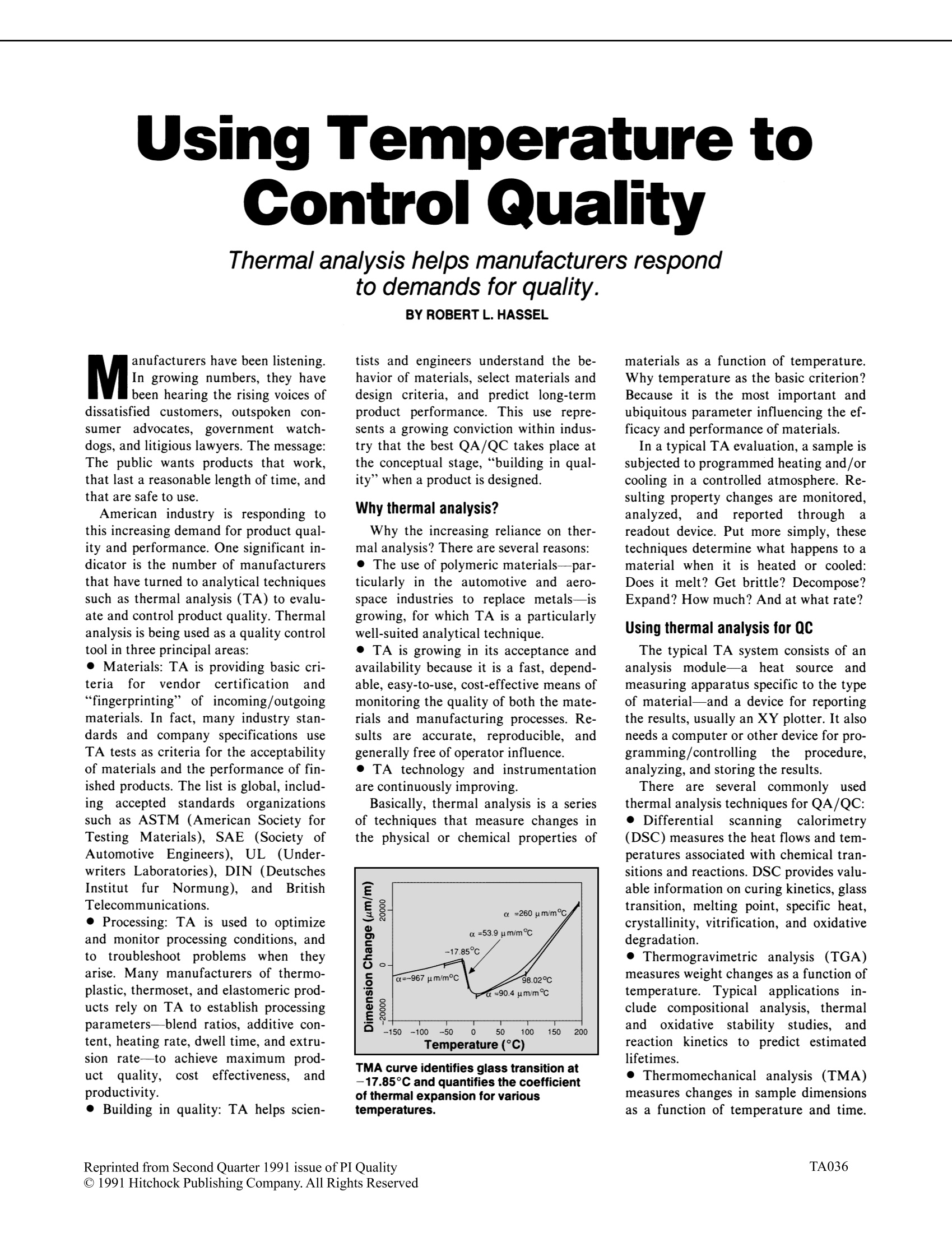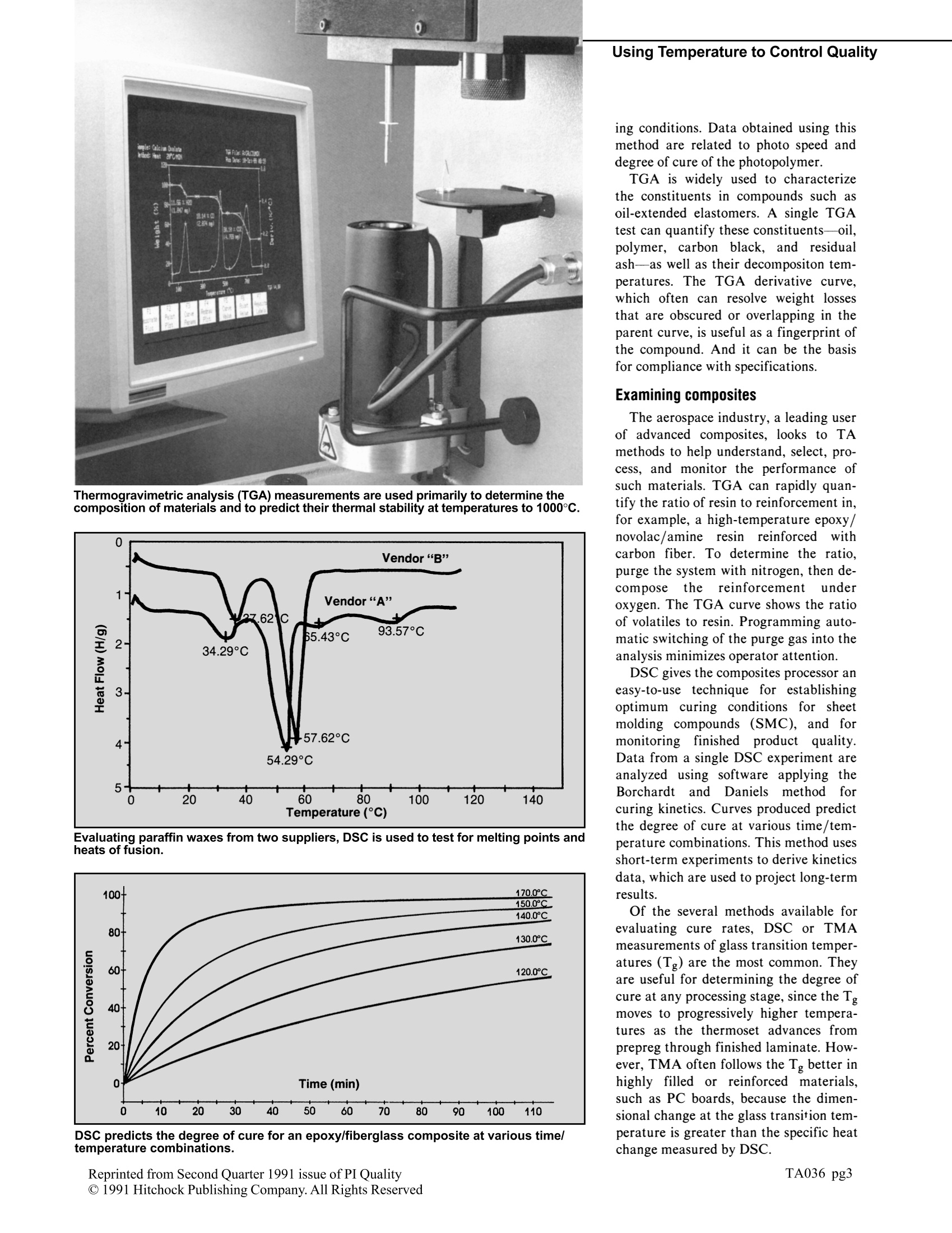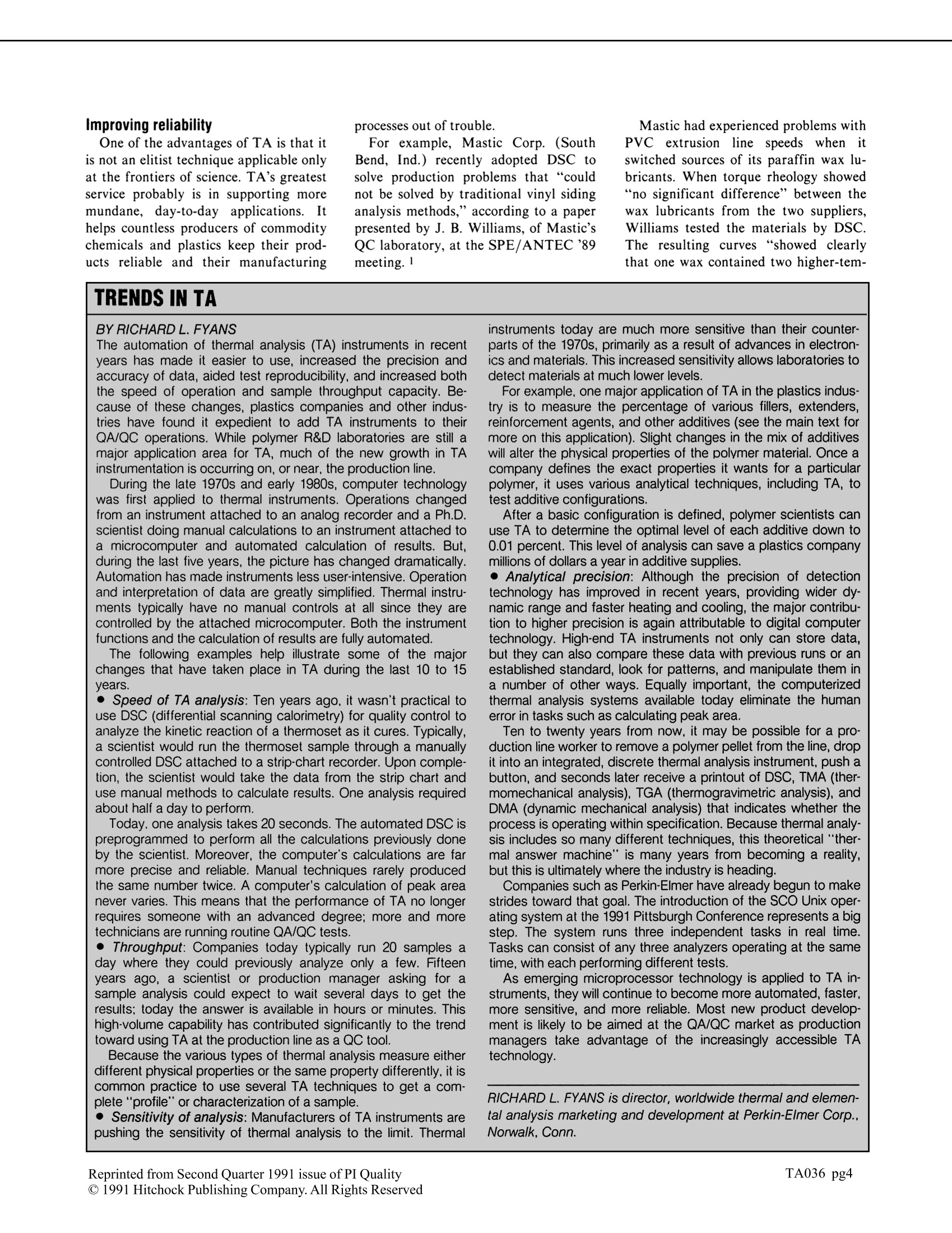
Manufactures have been listening. In growing numbers, they have been hearing the rising voices of dissatisfied customers, outspoken consumer advocates, government watchdogs, and litigious lawyers. The message: The public wants products that work, that last a reasonable length of time, and that are safe to use.?
方案详情

Using Temperature to Control Quality Using Temperature toControl Quality Thermal analysis helps manufacturers respondto demands for quality. BY ROBERTL. HASSEL anufacturers have been listening.MIn growing numbers, they havebeen hearing the rising voices ofdissatisfied customers, outspoken con-sumer advocates,,governmentitwatch-dogs, and litigious lawyers. The message:The public wants products that work,that last a reasonable length of time, andthat are safe to use. American industry is responding tothis increasing demand for product qual-ity and performance. One significant in-dicator is the number of manufacturersthat have turned to analytical techniquessuch as thermal analysis (TA) to evalu-ate and control product quality. Thermalanalysis is being used as a quality controltool in three principal areas: ·Materials: TA is providing basic cri-teriaforr vendorr certificationand“fingerprinting”of incoming/outgoingmaterials. In fact, many industry stan-dards and company specifications useTA tests as criteria for the acceptabilityof materials and the performance of fin-ished products. The list is global, includ-ing!aaccepted standards organizationssuch as ASTM (American Society forTesting Materials), SAE (Society ofAutomotiveeEngineers), UL (Under-writers Laboratories), DIN (DeutschesInstitutit fur Normung),and BritishTelecommunications. ·Processing: TA is used to optimizeand monitor processing conditions, andt)o troubleshoot problems wwhen theyarise. Many manufacturers of thermo-plastic, thermoset, and elastomeric prod-ucts rely on TA to establish processingparameters-blend ratios, additive con-tent, heating rate, dwell time, and extru-sion rate-to achieve maximum prod-uctquality,costeffectiveness, andproductivity. Building in quality: TA helps scien- tists and engineers understand the be-havior of materials, select materials anddesign criteria, and predict long-termproduct performance. This use repre-sents a growing conviction within indus-try that the best QA/QC takes place atthe conceptual stage, “building in qual-ity"when a product is designed. Why thermal analysis? Why the increasing reliance on ther- mal analysis? There are several reasons:· The use of polymeric materials-par-ticularly in the automotive and aero-space industries to replace metals-isgrowing, for which TA is a particularlywell-suited analytical technique. ·TA is growing in its acceptance andavailability because it is a fast, depend-able, easy-to-use, cost-effective means ofmonitoring the quality of both the mate-rials and manufacturing processes. Re-sults are accurate, reproducible, andgenerally free of operator influence. ·TA technology and instrumentationare continuously improving. Basically, thermal analysis is a seriesof techniques that measure changes inthe physical or chemical properties of TMA curve identifies glass transition at-17.85°C and quantifies the coefficientof thermal expansion for various temperatures. materials as a function of temperature.Why temperature as the basic criterion?Because it is the most important andubiquitous parameter influencing the ef-ficacy and performance of materials. In a typical TA evaluation, a sample issubjected to programmed heating and/orcooling in a controlled atmosphere.Re-sulting property changes are monitored,analyzed, andreporteddthrough areadout device. Put more simply, thesetechniques determine what happens to amaterial when it is heated or cooled:Does it melt? Get brittle? Decompose?Expand? How much? And at what rate? Using thermal analysis for QC The typical TA system consists of ananalysis module-a heat source andmeasuring apparatus specific to the typeof material—and a device for reportingthe results, usually an XY plotter. It alsoneeds a computer or other device for pro-gramming/controllingtheprocedure,analyzing, and storing the results. Thereare Iseveral commonlyusedthermal analysis techniques for QA/QC:● Differentialscanning calorimet(DSC) measures the heat flows and tem-peratures associated with chemical tran-sitions and reactions. DSC provides valu-able information on curing kinetics, glasstransition, melting point, specific heat,crystallinity, vitrification, and oxidativedegradation. · Thermogravimetric analysis (TGA)measures weight changes as a function oftemperature. Typicalaapplications in-cludee compositionalaanalysis, thermaland oxidativestabilitystudies,s,andreaction kinetics to predict estimatedlifetimes. ·Thermomechanical analysis (TMA)measures changes in sample dimensionsas a function of temperature and time. Thermal analysis characterizes many materials, including: thermoplastics, thermosets, composites, elastomers, films,fibers,ceramics, glass, metals, paint, adhesives, lubricants, and food products. TMA provides data on the coefficient ofthermal expansion (CTE), glass transi-tion temperature, gel time and tempera-ture, delamination temperature, resinflow, materials compatibility, and thestability of films and fibers. ·Dynamic mechanical analysis (DMA)measures sample modulus (stiffness) andenergy dissipation (damping)..DMAprovides information about transitiontemperatures, curing phenomena, andproperties such as impact resistance andsound absorption. Dielectric analysis (DEA), the newestTA technique, applies an alternatingelectrical field to measure the permittiv-ity and loss factor. This method is partic-ularly opportune for QC uses because ofits on-line applicability. Who uses thermal analysis? As might be expected, the leading pro-ponents of advanced quality and processcontrol techniques are high-technologyindustries such as aerospace, automotive,and electronics. But the companies thatdevelop and produce advanced materialsand components-predominantly com-panies in the process industries—are alsobecoming more involved. TA is used for electronics applicationsto test for dimensional stability, laminateand thermoset curing, gel times, andthermal stability. For example, the keyconcerns in the manufacture and use ofmultilayer printed circuit boards are thedimensional stability of individual layersand the degree of cure achieved in thepress or bonding cycle. U.S. automobile manufacturers in-clude a variety of thermal analysis testsin specifications for incoming raw mate-rials and components. A number of thesewere adopted after the easy-to-use ther-maltest methods were found to correlate TGA quantifies resin/reinforcement ratios for a high-temperature epoxy/novolac/amineresin reinforced with carbon fiber. closely with cumbersome, time-consum-ing traditional methods. Many automo-tive materials are currently evaluated byTA: seals, gaskets, engine and bodymounts, belts, bumpers, body panels, lu-bricants, paints and coatings,S, andadhesives. For elastomeric and polymeric materi-als, TMA measurements of dimensionalchanges, such as expansion and penetra-tion, can help define optimum processingconditions as well as end-use propertiesand operating temperature ranges. Forexample, anmanufacturer determinesthat the glass transition of its rubbercompound is at -17.85°C, the point atwhich the material becomes rigid andloses its damping characteristics. TMAtechniques can generate a curve to quan-tify the coefficient of thermal expansion(alpha) for various segments of the tem- perature range. This provides clues onthe rubber’s compatibility with adjacentcomponents, and its ability to maintain aseal. In another application, DSC curvesprovide information about the meltingpoint and range-key processing param-eters for thermoplastics-and the heat offusion. Using suitable reference materi-als, the heat of fusion can be convertedto percent crystallinity, an importantend-use parameter. With photosensitive and photocurablematerials, differential photocalorimetry(DPC) can measure transitions and reac-tions. Hercules Research Center (Wil-mington, Del.) uses DPC (a DSC acces-sory) as a QC tool to determine thepolymerization kinetics of its liquid pho-topolymers according to sample thick-ness, UV exposure, and ambient process- Thermogravimetric analysis (TGA) measurements are used primarily to determine thecomposition of materials and to predict their thermal stability at temperatures to 1000°C. Evaluating paraffin waxes from two suppliers, DSC is used to test for melting points andheats of fusion. DSC predicts the degree of cure for an epoxy/fiberglass composite at various time/temperature combinations. ing conditions. Data obtained using thismethod are related to photo speed anddegree of cure of the photopolymer. TGA is widely used to characterizethe constituents in compounds such asoil-extended elastomers. A single TGAtest can quantify these constituents-oil,polymer, carbon black, and residualash-as well as their decompositon tem-peratures. The TGA derivative curve,which often can resolve weight lossesthat are obscured or overlapping in theparent curve, is useful as a fingerprint ofthe compound. And it can be the basisfor compliance with specifications. Examining composites The aerospace industry, a leading userof advanced composites, looks to TAmethods to help understand, select, pro-cess, and monitor the performance ofsuch materials. TGA can rapidly quan-tify the ratio of resin to reinforcement in,for example, a high-temperature epoxy/novolac/amine resinnreinforcedwithcarbon fiber. To determine the ratio,purge the system with nitrogen, then de-compose thereinforcement underoxygen. The TGA curve shows the ratioof volatiles to resin. Programming auto-matic switching of the purge gas into theanalysis minimizes operator attention. DSC gives the composites processor aneasy-to-use technique for establishingoptimum curing conditions for sheetmolding compounds (SMC), and formonitoringfinishedl productquality.Data from a single DSC experiment areanalyzed using software applying theBorchardtt andDanielsmethodforcuring kinetics. Curves produced predictthe degree of cure at various time/tem-perature combinations. This method usesshort-term experiments to derive kineticsdata, which are used to project long-termresults. Of the several methods available forevaluating cure rates, DSC or TMAmeasurements of glass transition temper-atures (Tg) are the most common. Theyare useful for determining the degree ofcure at any processing stage, since the Tgmoves to progressively higher tempera-tures as the thermoset advances fromprepreg through finished laminate. How-ever,TMA often follows the Tg better inhighly filled or reinforced materials,such as PC boards, because the dimen-sional change at the glass transition tem-perature is greater than the specific heatchange measured by DSC. Improving reliability One of the advantages of TA is that itis not an elitist technique applicable onlyat the frontiers of science. TA’s greatestservice probably is in supporting moremundane, day-to-day applications. Ithelps countless producers of commoditychemicals and plastics keep their prod-ucts reliable and their manufacturing processes out of trouble. For example, Mastic Corp. (SouthBend, Ind.) recently adopted DSC tosolve production problems that “couldnot be solved by traditional vinyl sidinganalysis methods,”according to a paperpresented by J. B. Williams, of Mastic’sQC laboratory, at the SPE/ANTEC'89meeting.l Mastic had experienced problems withPVC extrusion line speeds when itswitched sources of its paraffin wax lu-bricants. When torque rheology showed“no significant difference" between thewax lubricants from the two suppliers,Williams tested the materials by DSC.The resulting curves “showed clearlythat one wax contained two higher-tem- BY RICHARD L. FYANS The automation of thermal analysis (TA) instruments in recentyears has made it easier to use, increased the precision andaccuracy of data, aided test reproducibility, and increased boththe speed of operation and sample throughput capacity. Be-cause of these changes, plastics companies and other indus-一tries have found it expedient to add TA instruments to theirQA/QC operations. While polymer R&D laboratories are still amajor application area for TA, much of the new growth in TAinstrumentation is occurring on, or near, the production line. During the late 1970s and early 1980s, computer technologywas first applied to thermal instruments. Operations changedfrom an instrument attached to an analog recorder and a Ph.D.scientist doing manual calculations to an instrument attached toa microcomputer and automated calculation of results. But,during the last five years, the picture has changed dramatically.Automation has made instruments less user-intensive. Operationand interpretation of data are greatly simplified. Thermal instru-ments typically have no manual controls at all since they arecontrolled by the attached microcomputer.Both the instrumentfunctions and the calculation of results are fully automated. The following examples help illustrate some of the majorchanges that have taken place in TA during the last 10 to 15years. ·Speed of TA analysis: Ten years ago, it wasn't practical touse DSC (differential scanning calorimetry) for quality control toanalyze the kinetic reaction of a thermoset as it cures. Typically,a scientist would run the thermoset sample through a manuallycontrolled DSC attached to a strip-chart recorder. Upon comple-tion, the scientist would take the data from the strip chart anduse manual methods to calculate results. One analysis requiredabout half a day to perform. Today. one analysis takes 20 seconds. The automated DSC ispreprogrammed to perform all the calculations previously doneby the scientist. Moreover, the computer's calculations are farmore precise and reliable. Manual techniques rarely producedthe same number twice. A computer’s calculation of peak areanever varies. This means that the performance of TA no longerrequires someone with an advanced degree; more and moretechnicians are running routine QA/QC tests. ·Throughput: Companies today typically run 20 samples aday where they could previously analyze only a few. Fifteenyears ago, a scientist or production manager asking for asample analysis could expect to wait several days to get theresults; today the answer is available in hours or minutes. Thishigh-volume capability has contributed significantly to the trendtoward using TA at the production line as a QC tool. Because the various types of thermal analysis measure eitherdifferent physical properties or the same property differently. it iscommon practice to use several TA techniques to get a complete "profile"or characterization of a sample. ·Sensitivity of analysis: Manufacturers of TA instruments arepushing the sensitivity of thermal analysis to the limit. Thermal instruments today are much more sensitive than their counter-parts of the 1970s, primarily as a result of advances in electron-ics and materials. This increased sensitivity allows laboratories todetect materials at much lower levels. For example, one major application of TA in the plastics indus-try is to measure the percentage of various fillers, extenders,reinforcement agents, and other additives (see the main text formore on this application). Slight changes in the mix of additiveswill alter the physical properties of the polymer material. Once acompany defines the exact properties it wants for a particularpolymer, it uses various analytical techniques, including TA, totest additive configurations. After a basic configuration is defined, polymer scientists canuse TA to determine the optimal level of each additive down to0.01 percent. This level of analysis can save a plastics companymillions of dollars a year in additive supplies. · Analytical precision: Although the precision of detectiontechnology has improved in recent years, providing wider dy-namic range and faster heating and cooling, the major contribu-tion to higher precision is again attributable to digital computertechnology. High-end TA instruments not only can store data,but they can also compare these data with previous runs or anestablished standard, look for patterns, and manipulate them ina number of other ways.Equally important, the computerizedthermal analysis systems available today eliminate the humanerror in tasks such as calculating peak area. Ten to twenty years from now, it may be possible for a pro-duction line worker to remove a polymer pellet from the line, dropit into an integrated, discrete thermal analysis instrument, push abutton, and seconds later receive a printout of DSC, TMA (ther-momechanical analysis), TGA (thermogravimetric analysis), andDMA(dynamic mechanical analysis) that indicates whether theprocess is operating within specification. Because thermal analy-sis includes so many different techniques, this theoretical "ther-mal answer machine" is many years from becoming a reality,but this is ultimately where the industry is heading. Companies such as Perkin-Elmer have already begun to makestrides toward that goal. The introduction of the SCO Unix oper-ating system at the 1991 Pittsburgh Conference represents a bigstep. The system runs three independent tasks in real time.Tasks can consist of any three analyzers operating at the sametime, with each performing different tests. As emerging microprocessor technology is applied to TA in-struments, they will continue to become more automated, faster,more sensitive, and more reliable. Most new product develop-ment is likely to be aimed at the QA/QC market as productionmanagers take advantage of the increasingly accessible TAtechnology. RICHARD L. FYANS is director, worldwide thermal and elemen-tal analysis marketing and development at Perkin-Elmer Corp.,Norwalk, Conn. Characterization Analysis Technique Characterization Analysis Technique Polymeric materials Electronic materials Composition TGA PC boards,prepregs DSC, TGA, TMA Blend compatibility TMA Solder masks, photoresists DSC, TMA, DPC* Polymer/reinforcement ratio TGA Liquid crystals DSC Additive content, effectiveness DSC, TGA Encapsulants DSC, TGA, TMA Flow, bleed, extrudability TMA Optical fibers DSC, TMA Polymer crystallinity DSC Insulating materials DSC, TGA, TMA Curing kinetics DSC Pharmaceuticals and fine chemicals Degree and rate of cure DSC, TMA Calorimetric purity DSC Thermal stability TGA/Kinetics Estimated lifetime Oxidative stability TGA/Kinetics DSC/Pressure DSC Edible oils Oxidative stability, shelf life DSC/Pressure DSC Dimensional stability TMA Lubricants Coefficient of thermal expansion TMA Oxidative stability DSC/Pressure DSC Delamination time, temperature TMA Cloud point, pour point DSC Thermal stability TGA Additives, compounding agents Wax content DSC Curing agents DSC, TGA, TMA *DPC (differential photocalorimeter) is a module operated as a DSC Reinforcers, blends DSC, TGA, TMA accessory to measure transitions and reactions in photosensitive and Plasticizers, modifiers DSC, TGA, TMA photocurable materials. Laboratory professionals develop new applications methods, and provide technicalsupport for customers. perature components that were not pres-ent in the other wax," he reported. Mastic has since modified its raw ma-terial specifications to include DSC testsfor melting points and heats of fusion,asdefinedby ASTMstandard testmethods. In another example, George Dugan,researchsupervisor of the polymercharacterization/thermal analysis labo-ratories at theHerculesResearchCenter, explains several ways that hiscompany uses thermal analysis for day-to-day QC and production support. Ac- cording to Dugan, TA helps Herculespredict product end-use performance,solve production problems, and assuretheissafeeproductionnof an unstablematerial: In polypropylene fiber production, theoxidation of the resin starting material isan important processing factor. Processstabilizer is added to minimize degrada-tion during high temperature extrusionof the resin. High-pressure DSC meth-ods help determine anti-oxidant levelsand ensure that the stabilizer is added atthe proper concentration. ·In packaging films, melting and crys-tallization of the starting materials af-fects the processing operating window. Italso affects end-use performance of thefinal product, especially in copolymericfilms. Hercules uses DSC andTMAmethods to characterize the flow proper-ties of both the resin and film. In filmsused for overwrap packaging applica-tions, shrinkage of 2 percent or less mustbe maintained to guarantee high-qualitygraphics; TMA provides the high sensi-tivity required to measure this shrinkageunder different loads. ·Liquid hydroperoxides, used primar-ily as polymerization initiators, decom-pose exothermically and some are auto-catalytic. Using DSC methods to studythe kinetic factors involved in the cata-lysis and decomposition of these materi-als, Hercules has established safe proc-essing, shipping, and storage procedures. Thermal analysis techniques are gain-ing ground in the quality arena as manu-facturers continue to search for faster,less costly methods of analysis. TA’spredictiveabilitiess help establishaframework for large-scale productionventures, further ensuring that quality isbuilt in as the product is designed. ( ROBERT L. HASSEL is vic e pr e sidentof planning for TA Instruments, New Castle, Del. ) ( References ) ( 1 . J. B. Williams,“Use of D SC as a Quality ControlTool," Society of Plastics Engineers, Analytical an d Technical Conference (SPE/ANTEC), 1989. ) TAeprinted from Second Quarter issue of PI QualityO Hitchock Publishing Company.All Rights Reserved Manufactures have been listening. In growing numbers, they have been hearing the rising voices of dissatisfied customers, outspoken consumer advocates, government watchdogs, and litigious lawyers. The message: The public wants products that work, that last a reasonable length of time, and that are safe to use.
确定





还剩3页未读,是否继续阅读?
TA仪器为您提供《产品中质量检测方案(热重分析仪)》,该方案主要用于其他中质量检测,参考标准--,《产品中质量检测方案(热重分析仪)》用到的仪器有
相关方案
更多
该厂商其他方案
更多








